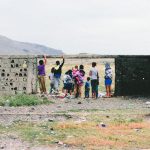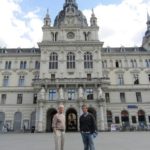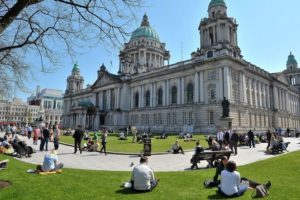
By Richard Ammon
July 2017
(photo right, Northern Ireland capital building in Belfast)
Our final stop on our round-the-country drive was Belfast, a huge working class city of half a million souls with about 70% Protestant and 30% Catholic. At one of the trendy city center restaurants, housed in the old Whig Newspaper Building, we chatted with David Speer, an out government social worker and his friends Steven and Darien and Ciara. Decorated with big communist statues from Poland, the warehouse-sized place buzzed with early evening weekend people out for food and drink.
Amidst the din of voices, Stephen made some salient points about today’s Belfast gay scene: (1) he reaffirmed that the ‘notorious’ Sinn Fein political arm of the IRA has the most progressive policies toward LGBT; they’re socialist minded and strong on human right-equality for everyone—Catholics and Protestants, men and women, gay and straight.
(2) the current sporadic violence is not religious or political but rather local paramilitary gangs shooting each other for turf and control of drug traffic. But still they do threaten to undo the peace accord because the British government demands they be disarmed. Defiantly they refuse saying it is the British who must disarm and leave Northern Ireland to govern itself.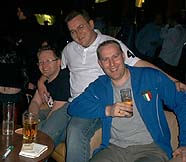 (photo left David Speer, center)
(photo left David Speer, center)
(3) Belfast as a gay community of strength, visibility, political influence is “10 years behind Dublin, 20 years behind London and light years from West Hollywood.” The generally conservative straight culture is quietly tolerant of gays but lacks understanding of homosexuality as a viable and natural way of life. There is still a lot of reluctance to rock the boat of those conservative politics and religious attitudes.
(4) Northern Ireland’s culture is changing a lot now that peace has come. It is more lawful and gays are less afraid to start showing up in public. Surprisingly, Belfast has had 11 annual gay pride marches although it has minimal social or political effect here; the festival is very localized and doesn’t command nearly the influence it does in London.
(5) Some rare violence happens against gays; in August 2002 a gay man was killed in a dark cruising area on the outskirts of town by three guys, one of whom was only 14. A sad case of a horny queer in the wrong place at the wrong time mixed with low class, boozed-up hooligans. The police apprehended the killers. (photo right: wall mural of IRA fighters) 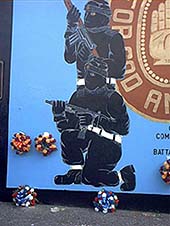
(6) Most of the killing, from ’68-’98, were in the neighborhood outskirts of west Belfast where many colorful and dramatic wall murals and defiant billboards can be seen depicting one sect over the other—loyalist Protestants against republican Catholics. In the city center, however, it was much calmer and in the cafes, clubs and restaurants there was always a friendly mix of people –such as this evening in the Whig bar. Protestant or Catholic, unionist (pro UK) or republican (pro-Ireland) hardly mattered to younger educated middle class citizens downtown. Many intermarried and were not concerned with such “irrelevant” matters as remaining loyal to UK or to Eire. Employment and happiness were more important.
Belfast Gay Places
A quick look in GCN news reveals a list of only 15 LGBT venues and services in Belfast. For a city of almost 400,000 it is not a large offering. At the time of my visit there were only three for four gay bars, discos, and clubs: Kremlin, Parliament, Custom House and gay friendly White’s Tavern. Another four listings are for HIV and health assistance and support including Rainbow Project and the AIDS phone Help Line. The rest of the offerings are support groups and meetings for lesbians, trans-people and Naturists. In the Cathedral Offices, directly across from St Anne’s Cathedral, are offices which house a sort of LGBT center called Cara Friend. Here is home to a phone help line, a gay rights advocacy group, and an LGBT support group called Queerspace.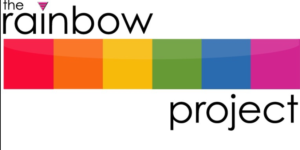
The Belfast Rainbow Project office is also downtown among the supermarkets, department stores and sidewalk cafes. It’s menu of AIDS/HIV services are the same as in Derry but with a larger caseload of course. Unfortunately when I stopped by their offices they were closed to the public because the Rainbow Board of Directors were meeting to plan their expanding future; they were powerfully assisted by a large grant from the Princess Diana Foundation.
Later I stopped by the Kremlin bar/disco the premier gay venue in Belfast (indeed, in all of Ireland, I think) two blocks away from the magnificent St. Anne’s Protestant cathedral downtown. The antithesis between these two places is obvious in the larger-than-life sized bronzed statue of Lenin in front of Kremlin bar, with his famous right arm stretched out to the future of Soviet Russia.
The manager, Gavin. showed me around and said Kremlin opened in 1999. The Russian theme was chosen for no particular reason. The dynamic and vibrant interior is predominantly red—of course. As the crowds pick up after 10:30 PM, the colored lights awaken as a smoke machine sends ‘fog’ into the main bar area and into the big dance room called Red Square. Backdrop to the Red Square stage is a large color image of the real Kremlin. Soviet style statues and busts overlook the dance floor action. Every night a live DJ spins volcanic sounds for the deaf-making youthful dancers writhing to the beat until 3:30 AM on weekends.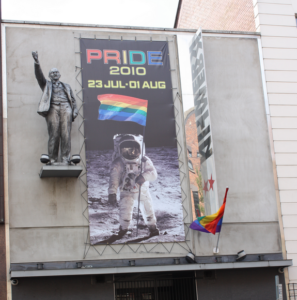
The place is jammed late at night starting about 11:30. There is a separate DJ in the front bar area where the lounge banquette seating is red leatherette upholstering with red lights bathing the walls. Gavin said there has never been a problem with the police with whom they have friendly relations. Kremlin staff check ID’s for over 18 and care is taken to keep the crowds at least 50% gay since the place is now popular also with straight kids who don’t care about sexual persuasions. (How do you tell the difference between gay and straight youth?)
Upstairs is a (sort of) quiet room with seats arranged around a balcony overlooking the entry. In the center is a big double brass chandelier. The place exudes lively and modern energy—a positive place for young gays to come out and feel they don’t have to hide in a dark or secretive place. It’s vibrant and upbeat with an ambience unlike other more traditional and quieter pub style bars such as the Custom House or Parliament bar.
Belfast’s Feminine Pulse
As in Dublin, some of the forces for advocating LGBT rights and dignity are not very public and not present in the popcorn night life. But insistent and thoughtful people are indeed at work in Belfast—owing, not surprisingly, in large measure to the lesbian community.
In March 2002, the Lesbian Advocacy Services Initiative (LASI) (e-mail: lasidykes@hotmail.com) published the results of a landmark wide-ranging survey “on the needs of lesbians and bisexual women in Northern Ireland.” It was appropriately titled ‘A Mighty Silence’ and was funded by both local and state agencies including the Northern Ireland First Minister’s office as well as the Equality Commission Northern Ireland.
The forty page report defines and clarifies how inequality, discrimination and social exclusion effect the everyday lives of lesbians and their families. This not to suggest that gay men are free of such abuse, but it is generally acknowledged that lesbians are more vulnerable for several reasons including physical strength, weaker economic power, the presence of an often hostile male spouse, having children as well as being victims to a diffuse social conditioning that demands women be submissive and tolerant of hardship.
Based on more than 200 live interviews with women, organizations and some gay men, the LASI report lays bare the unsettling reality that, despite legal changes since 1993 regarding homosexuality, “the experience of work, leisure, family and education for many lesbians is a story of vilification, isolation, ostracism and abuse.” Homophobia, in short, is alive and well in Northern Ireland (the report does not cover Ireland south.)
The most relevant recommendation by LASI is a significant increase in oversight support services, which in turn can help educate women to create local agencies—lesbian organizations. Such groups serve to meet such personal needs as trusted sharing, confidence building, support in coming out as well as a need to feel protected by local authorities against all forms of homophobia. Developing services at all levels, from national to village would serve to increase inclusion and decrease exclusion among disenfranchised lesbians–single, married or parenting.
The study also analyzed various inhibitors to developing such services. These include fear of violence, homophobic discrimination, low self-confidence, anguish in coming out, fear of ostracism at work, job loss and, very importantly, a strong dread of being separated from their children.
The impressive and moving report is more detailed than this simple summary. In an e-mail from the dedicated coordinator of the study, Marie Quiery, she stated: “Its major accomplishment has been to provide a necessary and realistic tool for developing street-wise goals and policies at the state level. With such an instrument in hand, the Belfast women’s community is now lobbying for specific changes in social and legal programs and legislation. We hope the future for lesbian women here will now be more defined, more hopeful.”
Concluding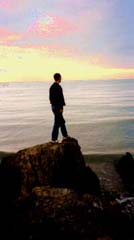
As with any foreign place, the experience of being in Belfast–indeed all of Ireland–was very different from the generalized and simplified image portrayed in the media and press. Belfast is worn but it’s not a combat zone. Walking the streets of this rough and picturesque city, seeing the dockyards where the Titanic was built, passing freely through the once-closed steel gates between Protestant and Catholic neighborhoods, admiring the enormous and magnificent neo-classical city hall, walking around the campus of Victoria University, attending the opera house, talking with gay and lesbian Northerners enjoying the current economic prosperity and peace—all these true-life sights and sounds are the real Belfast.
It’s a phoenix city, a vibrant place where LGBT people are growing in strength and gaining confidence to celebrate their Pride with a Festival, seasonal theme parties, warm friendships and a well-funded Rainbow Project. This is modern Belfast in the northern part of the Emerald Isle—a real jewel of a land.

